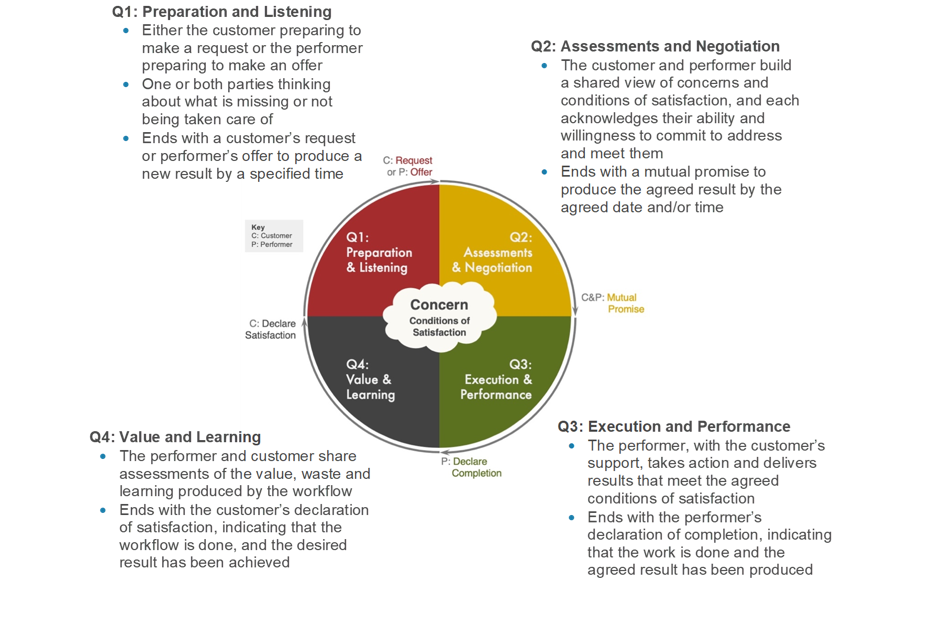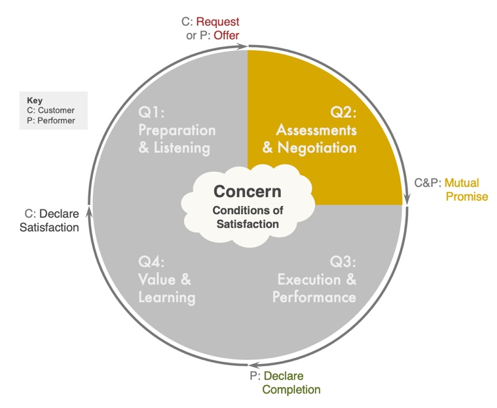Assessments and Negotiation: Crafting Mutual Commitments in Workflow
In the hustle of daily work, it’s easy to see tasks as isolated items on a to-do list, checked off one by one. Yet, work is rarely a solo endeavor. It’s a dynamic conversation between people striving to create a shared future, driven by what matters most to them. The workflow model, a universal framework for coordinating action, captures this reality by breaking work into four interconnected quadrants.

This is Article 3 in a five-part series that explores the application of Effective Workflow practices. Explore the other articles:
► Understanding workflow: A new paradigm for effective collaboration
► Preparation and Listening: The Foundation of Effective Workflow
► Execution and Performance: Delivering on Promises in Workflow
by Stewart Ramsay and Peter Claghorn, Vanry Associates
The workflow model redefines work as a conversation between two people, a customer and a performer, working together to create a shared future. This conversation unfolds across four quadrants, each critical to producing mutual value. After the groundwork of Preparation and Listening (Quadrant 1), where concerns are clarified and relationships assessed, Quadrant 2 (Q2), Assessments and Negotiation, is where the rubber meets the road. This phase is about transforming possibilities into concrete commitments, ensuring both parties agree on what success looks like and how it will be achieved. By mastering Q2, individuals can craft authentic promises that align with each other’s concerns, reduce waste, and strengthen relationships, setting the stage for successful execution in the next phase.

Q2 is the phase where the customer and performer negotiate the terms of their collaboration, culminating in mutual promises. It’s where the customer’s request or the performer’s offer is refined into a clear agreement, defined by Conditions of Satisfaction (COS)—specific criteria that outline what a successful outcome entails. Effective Workflow holds Q2 as the phase where customer and performer clarify what result will fulfill the request or offer, and what value the customer will provide to the performer in return. This clarity is crucial because it ensures both parties are aligned on expectations, resources, and priorities, minimizing misunderstandings that could derail the workflow later.
A key feature of Q2 is the concept of the dual loop, a parallel workflow where the roles reverse: the customer in the primary workflow becomes the performer in a secondary workflow, addressing the performer’s concerns. For example, when scheduling a car service, the primary workflow involves the customer requesting a service appointment and the performer (service representative) agreeing to deliver it. The dual loop ensures that the performer’s concerns—such as receiving payment or clear information about the car’s issues—are also addressed. This mutual value creation is what makes Q2 more than a transaction; it’s a partnership built on reciprocal care.
Customer Responsibilities in Q2

The customer’s role in Q2 is to listen carefully to the performer’s response and remain open to negotiation. In an Effective Q2, customers listen carefully to the responses of the performers—are their words saying promise but their body language / actions conveying something else?” This means paying attention to non-verbal cues, like hesitation or enthusiasm, which might indicate whether the performer’s commitment is authentic. For instance, if a manager requests a project proposal and the team member agrees but seems distracted, the customer should probe further to ensure alignment.
Customers must also be open to declines or counter offers. A performer who declines a request due to capacity constraints isn’t failing; they’re ensuring an authentic promise. The customer should respect this, as forcing a commitment can lead to breakdowns. We emphasize being “open to declines” and negotiating COS to ensure mutual value and that the customer has a commitment that they can rely on from the performer. For example, a client hiring a contractor to renovate a home might request a tight timeline. If the contractor counters with a longer schedule to ensure quality, the customer should engage in good-faith negotiation, balancing their concern (a timely renovation) with the performer’s (delivering high-quality work).
Additionally, customers provide “political care” if the performer needs to renegotiate with others. In a corporate setting, this might mean a manager advocating for their team member to secure resources from another department. The customer also ensures the COS address both parties’ concerns, including the dual loop. For instance, in the car service example, the customer agrees to provide payment and vehicle details (secondary workflow) to enable the service (primary workflow). By making clear requests and ensuring mutual value, the customer fosters a commitment that is both achievable and meaningful.
Performer Responsibilities in Q2
The performer’s role in Q2 is to ensure their promise is authentic and aligned with the customer’s concerns. Effective performers use declines, counteroffers and commit-to-commit, when necessary to ensure their promise is authentic. This means being honest about their capacity and resources. If a graphic designer is asked to deliver a logo in two days but knows quality work requires a week, they should counter with a realistic timeline rather than overpromising. This honesty builds trust and prevents future breakdowns.
Performers also assess the involvement of others before committing. For example, a service representative scheduling a car repair must confirm the availability of parts and technicians. They ensure the COS address the customer’s concerns (e.g., a reliable car by 4:00 PM) while also considering their own in the dual loop (e.g., receiving payment or clear instructions). Performers should continue taking care of the concerns of the customer even if they are negotiating or declining, ensuring the customer feels heard and valued.
Performers must also make clear requests about what they need to succeed. In a workplace scenario, a team member tasked with a report might request specific data from the customer to meet the deadline. By clarifying these needs upfront, the performer ensures the agreement is feasible. Performers should ensure mutual COS take care of their own concerns in the dual loop, balancing their own needs with the customer’s priorities.
Practical Applications and Tips
Mastering Q2 requires practical strategies to navigate negotiations and build trust. One key tip is to focus on clarity when defining COS. Both parties should ask, “What does success look like?” and agree on specific, measurable criteria, such as deadlines, quality standards, or resource requirements. For example, in the car service scenario, the COS might include a specific appointment time, the scope of repairs, and the cost. Writing these down can prevent ambiguity.
Another tip is to watch for non-verbal cues. A performer’s hesitant tone might signal doubts about their capacity, prompting the customer to renegotiate or offer support. Similarly, a customer’s impatience might indicate external pressures, allowing the performer to tailor their offer. Effective customers listen carefully to the response of the performer, which includes observing body language and tone.
Negotiating the dual loop is also critical. Performers should clearly state what they need—whether it’s resources, time, or information—to deliver successfully. Customers should acknowledge these needs, ensuring the performer feels valued. For instance, a manager might promise timely feedback to a team member drafting a proposal, addressing the performer’s concern for clear direction.
To diagnose Q2 issues, customers should ask, “Have I ensured the COS create mutual value?” Performers should reflect, “Is my promise authentic, and have I secured the resources I need?” If a workflow falters later, revisiting Q2 can reveal misaligned COS or unaddressed concerns. For example, if a project misses a deadline, it might stem from a vague agreement in Q2.
The Importance of Q2 in Workflow
Q2 is the linchpin of the workflow cycle because it transforms possibilities into actionable commitments. Without a clear, mutual promise, the execution phase (Q3) risks falling apart due to misaligned expectations or insufficient resources. If the customer demands the performer to act there is no workflow (it is an order). Effective Workflow is based on voluntary, authentic commitments. Q2’s focus on negotiation ensures both parties feel invested, fostering a relationship that can withstand challenges.
The dual loop is particularly powerful in Q2, as it ensures the performer’s concerns are addressed alongside the customer’s. This reciprocity strengthens the relationship, enabling more complex workflows in the future. For instance, a successful car service appointment builds trust, making the customer more likely to return to the same dealership. In a workplace, a manager and team member who negotiate a fair agreement strengthen their collaboration, paving the way for future projects.
Conclusion
Assessments and Negotiation (Q2) is where workflows take shape, turning shared concerns into concrete promises. By listening carefully, negotiating openly, and ensuring mutual value, customers and performers create agreements that are both achievable and meaningful. This phase isn’t about rushing to action but about crafting commitments that honor both parties’ concerns. The promises made will produce mutual value, setting the stage for the execution and performance in Quadrant 3. Whether scheduling a car service or launching a major initiative, Q2 is your chance to align expectations and build trust, ensuring the workflow delivers results that matter.
“In a culture in which people hold each other accountable for their impeccability, where commitments are taken seriously, there is trust, coordination, and efficiency. Perhaps most important, a culture of impeccability in commitments fosters a sense of achievement, dignity, and self-worth in its members.”
Banner & thumbnail credit: AI generated image by k a t t on Lummi